Psathyrella multipedata (Peck) A.H. Sm. - Clustered Brittlestem
Phylum: Basidiomycota - Class: Agaricomycetes - Order: Agaricales - Family: Psathyrellaceae
Distribution - Taxonomic History - Etymology - Identification - Culinary Notes - Reference Sources
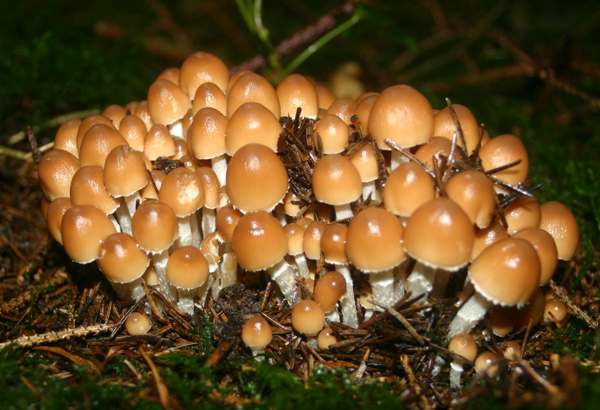
Several of the brittlestems fruit in clusters, but none in such dense posy-like bunches as Psathyrella multipedata. Although multipedata means having many feet, groups of the many legs within a cluster of these mushrooms share a single foot as they join to form a common base.
Look out for impressive tufted groups of Clustered Brittlestems on soil in open woodland as well as on lawns and roadside verges where there is buried rotten timber.
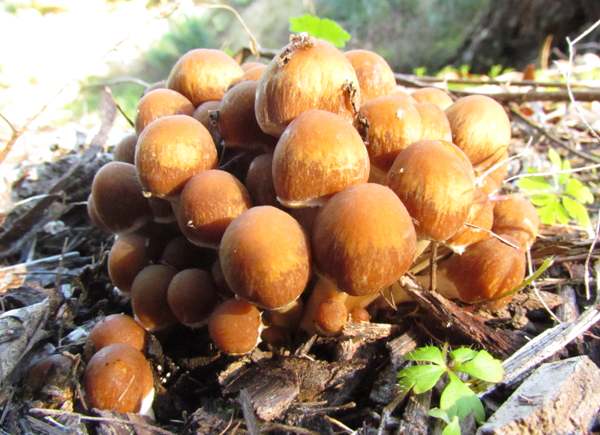
Distribution
Uncommon but quite widespread in woodlands throughout Britain and Ireland, the Clustered Brittlestem is also found throughout the European mainland and in many other countries including North America.
Taxonomic history
The basionym of this species dates from 1905, when American mycologist Charles Horton Peck (1833 - 1917) described the Clustered Brittlestem, giving it the binomial scientific name Psathyra multipedata.
It was not until 1941 that this woodland mushroom acquired its currently-accepted scientific name when another American, Alexander Hanchett Smith, transferred this species to the genus Psathyrella.
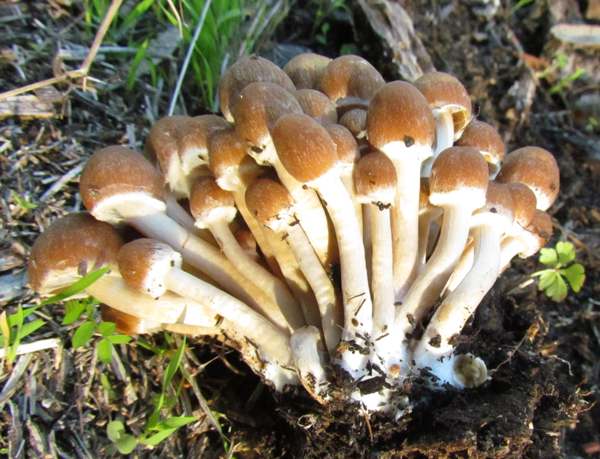
Synonyms of Psathyrella multipedata include Psathyra multipedata Peck, and Psathyra stipatissima J. E. Lange.
Etymology
Psathyrella, the genus name, is the diminutive form of Psathyra, which comes from the Greek word psathuros meaning friable; it is a reference to the crumbly nature of the caps, gills and stems of mushrooms in this genus, from which characteristic comes their collective common name 'brittlestem mushrooms'.
The specific epithet multipedata means 'with may feet' - a reference to the fact that these gregarious wood-rotting mushrooms grow in tufts from a common base as though treading on one another's toes. (The picture of the left of a group of Clustered Brittlestem mushrooms in souther Portugal illustrates this characteristic.)
Identification guide
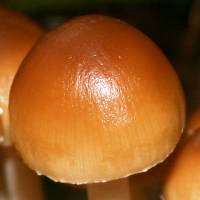 |
Cap0.5 to 3cm across, conical or convex and later bell shaped but never entirely flat; surface silky smooth; hygrophanous, reddish or clay brown when moist, drying pale ochre but often retaining a brownish centre. GillsAdnate or adnexed; light grey-brown with white edges, eventually turning dark brown. Stem4 to 10cm long and 3 to 6mm dia.; white at the apex, browner towards base; no ring; several stems fused together at base to form clusters. |
SporesEllipsoidal, smooth, 6.5-10 x 3.5-4um, with a germ pore. Spore printDark purple-brown. |
|
Odour/taste |
Not distinctive. |
Habitat & Ecological role |
Saprobic, on buried wood and rotting fallen timber in open woodland. |
Season |
June to November in Britain and Ireland. |
Similar species |
The Common Stump Brittlestem Psathyrella piluliformis, which grows on dead hardwood, is a pale clay-brown when young and dries to be come ochre and eventually almost white. |
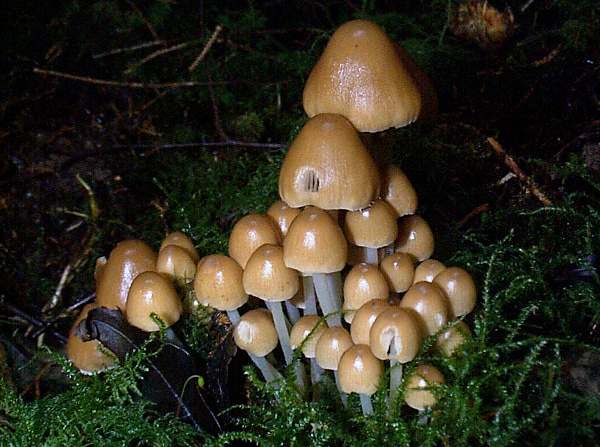
Culinary Notes
In many (but not all) field guides Psathyrella multipedata is recorded as 'edible but not worthwhile', while a field guides record it as inedible or edibility unknown. These mushrooms are insubstantial and it would take a lot of them to make a meals, so unless you are desperate and nothing else is available the Clustered Brittlestem is probably not worth considering as a culinary collectible.
Reference Sources
Fascinated by Fungi, 2nd Edition, Pat O'Reilly 2016, reprinted by Coch-y-bonddu Books in 2022.
Bertrand, G. (1913). Quelques notes sur les Psathyra et les Psathyrella récoltés en Lorraine. Bulletin Trimestriel de la Société Mycologique de France 29: 185-188, tab. 8.
Dictionary of the Fungi; Paul M. Kirk, Paul F. Cannon, David W. Minter and J. A. Stalpers; CABI, 2008
Taxonomic history and synonym information on these pages is drawn from many sources but in particular from the British Mycological Society's GB Checklist of Fungi.
Fascinated by Fungi. Back by popular demand, Pat O'Reilly's best-selling 450-page hardback book is available now. The latest second edition was republished with a sparkling new cover design in September 2022 by Coch-y-Bonddu Books. Full details and copies are available from the publisher's online bookshop...

